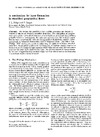Identificador persistente para citar o vincular este elemento:
https://accedacris.ulpgc.es/handle/10553/72982
| DC Field | Value | Language |
|---|---|---|
| dc.contributor.author | Pelegrí Llopart,José Luis | en_US |
| dc.contributor.author | Sangrá Inciarte, Pablo | en_US |
| dc.date.accessioned | 2020-06-04T12:39:12Z | - |
| dc.date.available | 2020-06-04T12:39:12Z | - |
| dc.date.issued | 1998 | en_US |
| dc.identifier.issn | 2169-9291 | en_US |
| dc.identifier.other | WoS | - |
| dc.identifier.other | Scopus | - |
| dc.identifier.uri | https://accedacris.ulpgc.es/handle/10553/72982 | - |
| dc.description.abstract | We discuss the possibility that steplike structures are formed in subcritical regions of vertically stratified shear flow. The mechanism we propose essentially consists of localized intense mixing in highly stratified and sheared flows, probably following frontogenesis. Its main assumption is that the vertical density flux increases monotonically with decreasing gradient Richardson numbers, which corresponds to enhanced stratification and/or diapycnal shear. This differs from Phillips' [1972] mechanism, which we argue may not apply to vertically stratified shear flow. An essential condition for the formation of constant density steps is the incorporation of a Langevin type equation which takes into account that turbulence must last for some finite characteristic time. We present numerical computations for the case of approximately constant diapycnal shear which lead to the formation of a staircase depth-density structure. | en_US |
| dc.language | eng | en_US |
| dc.relation.ispartof | Journal of geophysical research. Oceans | en_US |
| dc.source | Journal Of Geophysical Research-Oceans [ISSN 2169-9291], v. 103 (C13), p. 30679-30693, (Diciembre 1998) | en_US |
| dc.subject | 2510 Oceanografía | en_US |
| dc.subject.other | Gulf-Stream | en_US |
| dc.subject.other | Boundary Currents | en_US |
| dc.subject.other | Shear-Flow | en_US |
| dc.subject.other | Turbulence | en_US |
| dc.subject.other | Fluids | en_US |
| dc.subject.other | Parameterization | en_US |
| dc.subject.other | Thermocline | en_US |
| dc.subject.other | Instability | en_US |
| dc.subject.other | Energetics | en_US |
| dc.subject.other | Transport | en_US |
| dc.title | A mechanism for layer formation in stratified geophysical flows | en_US |
| dc.type | info:eu-repo/semantics/Article | en_US |
| dc.type | Article | en_US |
| dc.identifier.scopus | 18544395119 | - |
| dc.identifier.isi | 000077974900005 | - |
| dc.contributor.authorscopusid | 7003869003 | - |
| dc.contributor.authorscopusid | 6602684473 | - |
| dc.identifier.eissn | 2169-9291 | - |
| dc.description.lastpage | 30693 | en_US |
| dc.identifier.issue | C13 | - |
| dc.description.firstpage | 30679 | en_US |
| dc.relation.volume | 103 | en_US |
| dc.investigacion | Ciencias | en_US |
| dc.type2 | Artículo | en_US |
| dc.contributor.daisngid | 358123 | - |
| dc.contributor.daisngid | 763696 | - |
| dc.description.numberofpages | 15 | en_US |
| dc.utils.revision | Sí | en_US |
| dc.contributor.wosstandard | WOS:Pelegri, JL | - |
| dc.contributor.wosstandard | WOS:Sangra, P | - |
| dc.date.coverdate | Diciembre 1998 | en_US |
| dc.identifier.ulpgc | Sí | es |
| dc.description.jcr | 2,577 | |
| dc.description.jcrq | Q1 | |
| item.grantfulltext | open | - |
| item.fulltext | Con texto completo | - |
| crisitem.author.fullName | Pelegrí Llopart, José Luis | - |
| crisitem.author.fullName | Sangrá Inciarte, Pablo | - |
| Appears in Collections: | Artículos | |
SCOPUSTM
Citations
25
checked on Jun 8, 2025
WEB OF SCIENCETM
Citations
24
checked on Feb 25, 2024
Page view(s)
126
checked on May 31, 2025
Download(s)
211
checked on May 31, 2025
Google ScholarTM
Check
Share
Export metadata
Items in accedaCRIS are protected by copyright, with all rights reserved, unless otherwise indicated.
